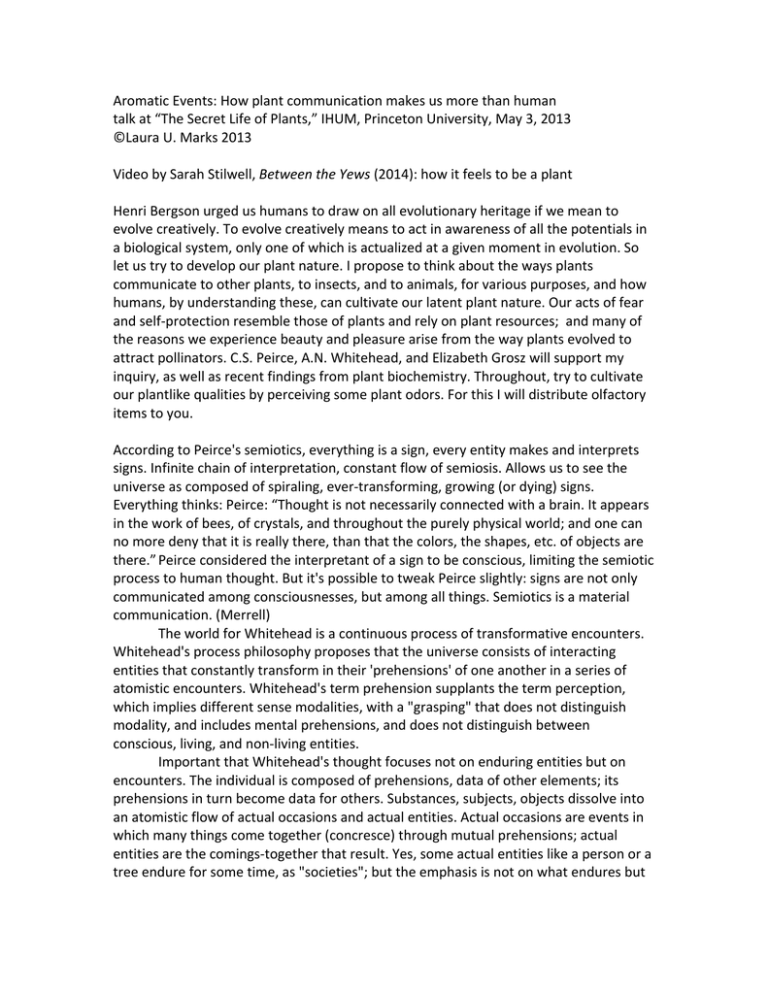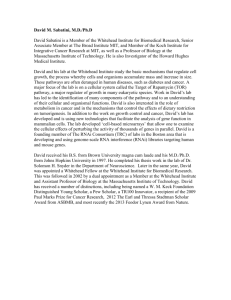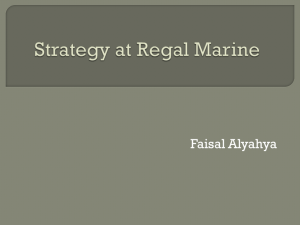Document 12711687
advertisement

Aromatic Events: How plant communication makes us more than human talk at “The Secret Life of Plants,” IHUM, Princeton University, May 3, 2013 ©Laura U. Marks 2013 Video by Sarah Stilwell, Between the Yews (2014): how it feels to be a plant Henri Bergson urged us humans to draw on all evolutionary heritage if we mean to evolve creatively. To evolve creatively means to act in awareness of all the potentials in a biological system, only one of which is actualized at a given moment in evolution. So let us try to develop our plant nature. I propose to think about the ways plants communicate to other plants, to insects, and to animals, for various purposes, and how humans, by understanding these, can cultivate our latent plant nature. Our acts of fear and self-­‐protection resemble those of plants and rely on plant resources; and many of the reasons we experience beauty and pleasure arise from the way plants evolved to attract pollinators. C.S. Peirce, A.N. Whitehead, and Elizabeth Grosz will support my inquiry, as well as recent findings from plant biochemistry. Throughout, try to cultivate our plantlike qualities by perceiving some plant odors. For this I will distribute olfactory items to you. According to Peirce's semiotics, everything is a sign, every entity makes and interprets signs. Infinite chain of interpretation, constant flow of semiosis. Allows us to see the universe as composed of spiraling, ever-­‐transforming, growing (or dying) signs. Everything thinks: Peirce: “Thought is not necessarily connected with a brain. It appears in the work of bees, of crystals, and throughout the purely physical world; and one can no more deny that it is really there, than that the colors, the shapes, etc. of objects are there.” Peirce considered the interpretant of a sign to be conscious, limiting the semiotic process to human thought. But it's possible to tweak Peirce slightly: signs are not only communicated among consciousnesses, but among all things. Semiotics is a material communication. (Merrell) The world for Whitehead is a continuous process of transformative encounters. Whitehead's process philosophy proposes that the universe consists of interacting entities that constantly transform in their 'prehensions' of one another in a series of atomistic encounters. Whitehead's term prehension supplants the term perception, which implies different sense modalities, with a "grasping" that does not distinguish modality, and includes mental prehensions, and does not distinguish between conscious, living, and non-­‐living entities. Important that Whitehead's thought focuses not on enduring entities but on encounters. The individual is composed of prehensions, data of other elements; its prehensions in turn become data for others. Substances, subjects, objects dissolve into an atomistic flow of actual occasions and actual entities. Actual occasions are events in which many things come together (concresce) through mutual prehensions; actual entities are the comings-­‐together that result. Yes, some actual entities like a person or a tree endure for some time, as "societies"; but the emphasis is not on what endures but on what changes. Subjects are not fixed in Whitehead: rather, what emerges from each encounter is a superject. Prehension: act by which one actual entity takes up and responds to another. Plant prehends sun, water, insects, pollution, which also prehend it. A thirsty plant draws up water, becomes superject, a non-­‐thirsty plant. Roots prehend soil, and water in soil; soil and water prehend roots. Each feels itself being changed in the encounter: roots osmose water, water moves into plant, is taken into cells; soil dries. (We can also consider actual occasions to occur on smaller and larger scales: at the chemical level, the electrical level.) When this actual occasion is completed or satisfied, plant, soil, and water are all transformed. Satisfaction: the end of a prehension. Whitehead rejects subject-­‐predicate forms of thought, which assumes things remain the same. Abandon the copula! Not "The tree is green" but "The tree greens." To appreciate what we have in common with plants, to share the feelings or prehensions of plants, does not at all require us to limit or "dumb down" our consciousness. Instead, it amplifies it. Whitehead critiqued the "bifurcation of nature" whereby objective nature appears separate from perceptions of nature.1 If instead, in the manner of process philosophy, we treat our encounters with nature as events that continually produce us anew, we can appreciate that we constantly become in our interactions with all of nature, including plants. As Isabelle Stengers explains, "The task of philosophy is not only to produce concepts which put in ‘sheer disclosure’ the wonderful efficacy of the expressive sign as that which primordially matters for us as conscious beings. The task of philosophy is also to elucidate those aspects of experience which do not matter in the same way, for instance because they are always there, even when the community of intuition breaks down and you stop understanding what somebody says to you."2 In this way, process philosophy can give rise to a new curiosity about how it is that we respond to the beauty, grace, tenacity, and inventiveness of plants. Plants communicate with each other and with creatures in many ways. I'll focus on chemical communication. Plants inform each other of stress, such as infestation and drought, so they can respond to it. For example, a study of Pisium sativum, the field or garden pea, shows that plants inform each other about drought through the roots. Plants' skin is covered with stomata, microscopic pores. In drought, the stomata close to prevent dehydration. Experimenters planted Pisium sativum in shared pots. They mimicked drought by applying mannitol to one plant. Then they measured aperture of the plants' stomata, or pores. 15 minutes after experimenters injected mannitol into the one plant, its stomata and that of the neighbors sharing its receptacle closed by 39%; after one hour, drastically closed, to conserve water. This shows that stressed plants communicate to unstressed plants through roots; the unstressed plants respond even though they are not suffering themselves. In turn the unstressed plants release stress 1 A.N. Whitehead, Science and the Modern World (New York: The Free Press, 1967), 64; cited in Stengers. 2 Isabelle Stengers, "A Constructivist Reading of Process and Reality," Theory, Culture, & Society 25:4 (2008): 102. cues to other plants, creating "cascading chain of stress responses" in more distant plants.3 Plants also communicate to insects. Here we can more easily share their communication. I suggest this is an aesthetics, in Whitehead's meaning that aesthetics involve the decision of how to prehend something. We can amplify our aesthetic prehension of plants by learning to interpret the signs they make to one another. One way to do this is through the nose. Please smell sample #1. We recognize it as the smell of a conifer. It's the balsam fir, abies balsamea, which grows across Canada and in this part of the US. More specifically, we are smelling the balsam fir's "call for help." When a plant is infested it can respond in several ways. Sometimes plants emits toxins that sicken the attacking insect (for example, wild tobacco poisons its attackers with nicotine). However, specialist herbivores can tolerate these toxins. So direct defense not necessarily the best defense. Instead, an attacked plant takes an indirect defense, emitting chemicals that both attract carnivorous insects and warn other plants.4 An infested plant emits a complex cocktail of chemicals. These are different from the usual combination of chemicals that a plant yields through ruptures in its skin: the smell you get when you press a leaf. Plant physiologists have studied this indirect defense since the late 1980s. Recent studies focus on complex systems' community interaction. When a herbivore attacks, plants emit chemicals that attract carnivores to eat the predator or its larvae. To do this they rearrange the transcription of their DNA, inducing genes involved in production of phytohormones. Infested plants emit Herbovire-­‐induced Plant Volatiles (HIPV) that can include hundreds of components. These get produced within hours to days of infestation. Plants actually go to the trouble to emit different odor blends that attract different kinds of carnivores. Uninfested plants, receiving the call for help, respond by heightening their defenses. Abies balsamea's predators include moose, squirrels, birds, and caterpillars of the lo moth (Wikipedia), as well as human harvesters for turpentine and Christmas trees. When it is attacked, I expect it behaves similarly to the Scots pine. When sawflies deposit their eggs on the Scots pine, the plant changes its metabolism of terpenoids; in three days, it is able to attract a wasp that attacks the insect's eggs. 5 The title of this article; “A Plant Notices Insect Egg Deposition and 3 Omer Falik, Yonat Mordoch, Lydia Quansah, Aaron Fait, Ariel Novoplansky, "Rumor Has It...: Relay Communication of Stress Cues in Plants," Plos One, November 2, 2011 4 Arimura et al. 5 Roland Schräder, Manfred Forstreuter, and Monika Hilker, “A Plant Notices Insect Egg Deposition and Changes Its Rate of Photosynthesis,” Plant Physiology 138:1 (May 2005): 470-­‐477. Changes Its Rate of Photosynthesis,” uses an intentional verb: the plant notices that it is in danger and acts to defend itself.6 Similarly, Marcel Dicke's approach to the "behavioural ecology of plant," examines plants' decisions. Because working on self-­‐ defense diverts the plant's energy from photosynthesis (Schröder et al.), it needs to decide whether, when, and for how long to produce odors that will attract predators. We humans emit on olfactory call for help too: when we feel fear or disgust, the odor of our sweat changes. When our peers smell us, share what we are feeling even without knowing the cause, and they react appropriately, for example by fleeing. So the clean, fresh smell of the balsam fir is actually the tree's call for help; and sadly, it was calling for help precisely because it was being processed into this refreshing oil for human use. The odor may give you a brisk and fresh feeling; the result, perhaps, of having successfully eradicated your enemies. For when we use pine-­‐derived products to clean our rooms, we are protecting ourselves against microbes using the chemicals plants secrete for self-­‐protection. I suggest that this association is both cultural and genetic. Why do we find the scents and colors of many flowers beautiful? Because the flowers and their animal admirers have taught us. Now I'd like to consider plants' attractive smells in light of Elizabeth Grosz's stimulating argument that sexual selection, rather than natural selection, is the origin of art. Darwin's account of natural selection informed modern emphasis on survival of the fittest. Disdain of pleasure, ornament, frivolity, femininity as unnecessary to life. Can see its influence in the more rigorous and joyless aspects of contemporary art. But thinking in the terms of creative evolution, it's high time to appreciate the activities of our floral and faunal kin in terms of the pleasure and seemingly useless novelty they engender. Sexual selection redirects living things' energy away from mere survival to a pleasure and curiosity that enhance perception and intensify life. Grosz argues that we have a world to perceive because animals made it; I think we must add plants as co-­‐creators. Birds sing to attract (and warn) others. The male stickleback turns translucent and shimmery in mating season. There's recent evidence that dinosaurs had peacock-­‐like tails! Flowers produce scents and colors to attract pollinators. And because of these, we humans learn about music, about spectacle, about color and scent. Grosz writes, "It is the animal in us [and the plant in us] that directs us to art…. Art is the way nature deviates itself from givenness."7 We become more than just the human animal by cultivating potentials for new experience, by creating sense 6 A similar study finds that when larvae of the fall armyworm eat the leaves of the cowpea, their oral secretions stimulate the plant to produce phytohormones that emit volatile chemicals that attract the armyworm’s natural predators. It seems that in the vegetable world, the enemy of my enemy is my friend. Eric A. Schmelz, Sherry LeClere, Mark J. Carroll, Hans T. Alborn and Peter E.A. Teal, “Cowpea Chloroplastic ATP Synthase Is the Source of Multiple Plant Defense Elicitors during Insect Herbivory,” Plant Physiology 144 (2007):793-­‐805. 7 Elizabeth Grosz, "Art and the Animal," Becoming Undone, 172. experiences beyond our needs: and the flowers and plants play a large role in teaching us how to do this! In these ways we experience beauty because plants and insects do. In addition, when we experience the healing and toxic powers of plants, we are able to do this because the plants made a world for us. However, I don't want to focus only on the "useful" properties of plants. Rather I follow Grosz's Deleuzian lead in appreciating the ways nature creates intensifications. For these are the reasons we humans create and are drawn to beauty and novelty. So please smell sample #2. This is the scent of oil of ful from Damascus. An especially frangrant variant of the Arabic morning greetings "Sabah al-­‐khayr" and "Sabah al-­‐nur" is "Sabah al-­‐ful": a morning of wild jasmine. Photo from Cairo, where lovers buy garlands of ful and taxi drivers hang them from their rear-­‐view mirrors (it is said; I have never seen it). Wild jasmine, Arabian jasmine (though originates SE Asia), jasminium sambac. Pollinated at night by moths. Many flowers' aromas fall below the human olfactory radar. But when we smell ful we share the moth's attraction to the flower's sexual lure. We also share the pleasure of this scent with people in Syria and Egypt people in Syria and Egypt who find relief and pleasure in a whiff of ful. The bouquet of fragrant flowers may contain just a few chemicals or over a hundred.8 Oil of jasminium sambac is a mixture of many chemicals including the fragrant coumarin (new-­‐mown hay) linalool (spicy floral), methyl anthranilate (grape), and other chemicals with medicinal properties.9 Used to flavor jasmine tea; it is an antioxidant and anti-­‐depressant and used traditionally to treat ailments from depression to cancer.10 So when we scent ourselves with oil of ful, we borrow the flower's moth-­‐ seductive powers to attract other humans. And when we administer ful to treat anxiety or illness, we are drawing on the floral knowledge within ourselves: on our ful-­‐like nature. Whose experience are we sharing when we smell plants? We share the experience of other plants receiving the "call for help." But my two examples suggest that when we 8 Jette T. Knudsen and Jonathan Gershenzon, "The Chemical Diversity of Floral Scent," Biology of Floral Scent, ed. Natalia Dudareva and Eran Pichersky (Taylor and Francis, 2006), 27-­‐52. 9 Arun Mittal, Satish Sardana, Amina Panday, "Ethnobotanical, Phytochemical, and Pharmacological Profile of Jasminum sambac (L.) Ait.," Journal of Pharmaceutical and Biomedical Sciences 11:5 (2011) 10 Mittal et al.; Phanukit Kunhachan, Chuleratana Banchonglikitkul, Tanwarat Kajsongkram, Amonrat Khayungarnnawee, and Wichet Leelamanit, "Chemical Composition, Toxicity and Vasodilatation Effect of the Flowers Extract of Jasminum sambac (L.) Ait. 'G. Duke of Tuscany,'" Evidence-­‐Based Complementary and Alternative Medicine 2012 (2012), Article ID 471312, 7 pages. smell we are "identifying" with insects, not plants: cultivating our insect nature, not our plant nature. To insist that we become plantlike as well in these encounters, I return to Whitehead. It's not necessary to separate subject and object, smeller and smellee. In the moment of chemical communication all parties enter into an actual occasion, where we prehend those parts of each other that are relevant to us. Both chemistry and process philosophy emphasize that a delicate and precise meeting takes place at the molecular level. In a mimetic dance between the chemistry (at several levels) of the plant's signal and that of its receptors in other plants and animals, including us, we chemically press close to each other and take each other's shape. At the molecular level there's no subject-­‐object. Rather there is a mutual becoming; an event, in which all parties become transformed. At this atomistic level, we do indeed have much in common with plants, as well as the insects that pollinate, predate and protect them. And these mutual becomings between flower and insect, fragrance and nose, make us atomistic kin with all others who have experienced the scream of the balsam pine and the seduction of wild jasmine.






